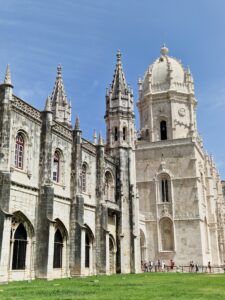Visit Jerónimos Monastery , Lisbon
If you are planning to visit Jerónimos Monastery in Lisbon, a UNESCO World Heritage Site, here is everything you need to know.

Plan your visit
When you are visiting Jerónimos Monastery, do so early or closer to closing time, as it will be a long queue to enter that forms outside in the sun without any shade. Tickets you have to buy online beforehand, and do so before you stand in the queue, otherwise you have to go and buy your ticket and come back.
If you have the Lisbon card you will go in for free, you show it as you get to the front of the queue, and then you register as you get inside. Standard emission is 10,00€.
Jerónimos Monastery History
Construction of Jerónimos Monastery started in 1502, after King Manuel requested a papal bull for the building in 1495. It would take 100 years to complete, measuring 300m in length, built in limestone facing the river Targus. It would have been hard to miss. In those days, Belém, today a busy part of Lisbon, was no more than a small medieval village. The new Jerónimos Monastery must have been overwhelming for the locals.
The building is considered being a masterpiece and would be known as an architectural monument in the Manueline style, being King Manuel’s largest prestige project as monarch.
The architectural style is known for its it elaborate and ornate style being inspired by the sea. It is very busy and intricate, which can clearly be seen at the monastery today.
The building would survive the devastating 1755 earthquake, mostly intact, and became a UNESCO World Heritage Site in 1983.
In 1833, the monastery was abandoned as the religious orders were dissolved. After the 1850 restoration, we find the National Archaeological Museum and the Maritime Museum in the monastery’s west wing.



The Cloisters
The cloisters span over two floors in a square 55x55m square. The lower level has a classic overlay while the upper level is more recessed. The structure that was built, was an innovation.
Each of the cloister’s wings has 6 bays with decorated vaults, with the four inner bays resting on massive buttresses, forming broad arches. A diagonal arched construction links the corner bays and shows the richly carved corner pillars.
The monastery also has a clear link to the Renaissance style with its rounded arches and horizontal structure architecture.


The Santa Maria Church
Santa Maria Church is a three aisles church with five bays under a single vault, with a slightly prominent transept and a raised choir. Both sides of the aisles have altars in the Manueline style, dating to the 16th– and 17th– century. The vaulted ceiling has octagonal pillars reaching up to a webbed dome. These 25m high pillars had typical Renaissance elements. The stained-glass windows are unfortunately modern, dating from the 1930s.
The church is a resting place for the royal family. The tomb rests on elephants, made of marble. King Manuel I, Queen Maria of Aragon, rest on the left side while Kung João III and Queen Catherine of Austria on the right side.


UNESCO World Heritage Site
In 1983, the Jerónimos Monastery and Santa Maria Church became, along with the nearby Tower of Belém, a UNESCO World Heritage Site. The Monastery, that survived the 1755 earthquake is considered a National monument in Lisbon and Portugal.

Accessibility and facilities
There is accessibility to the Jerónimos Monastery, however while inside it is palatially limited. The facilities include accessibility to WC.
The Jerónimos Monastery, does not have a museum shop.
Public transport
By Bus:
Mosteiro Jerónimos: no. 15E, 79B and 728, 729. This bus stop is just opposite the monastery.

Tickets
Adult 10,00€
Student 5,00€
65 and over 5,00€
Lisbon Card enters for free
Children 0-12 years old enters for free
Opening times
May to October:
Tue-Sun 9.30am to 6.00pm (Mon closed)
October to May:
Tue-Sun 10.00am to 5.30pm (Mon Closed)
